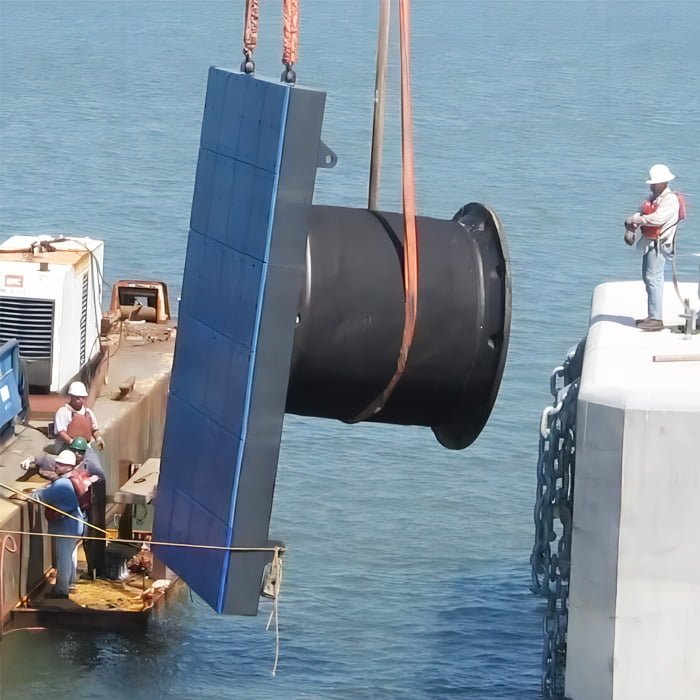Do Shipyards with Dry Docks Still Need Ship launching Airbags?
09/15/2025Service life of cell fenders
Today, as science and technology continue to develop and update, the marine industry has also benefited from these advancements. Continuous innovation in engineering materials and design has allowed ports and shipyards to work more safely, efficiently, and with lower costs. In this process, marine fender systems have received more attention. Among them, cell fenders stand out as durable and reliable structures. However, their service life remains a key concern for engineers, operators, and procurement teams around the world.


Factors That Influence Service Life
The service life of cell fenders is not determined by a single element but by a combination of materials, design, environment, and operational practices.
- Material and Formulation
The quality of rubber and reinforcing materials directly affects resistance to cracking, aging, and deformation. Advanced compounds with anti-oxidation and anti-UV additives usually provide longer service life. - Design and Geometry
The structure and dimensions of a cell fender determine its energy absorption capacity. A well-designed fender distributes loads evenly and avoids weak stress points, which helps reduce premature failure. - Manufacturing Quality
Precision during molding, vulcanization, and embedded steel reinforcement determines consistency. A small defect in production can shorten the service life significantly. - Operating Conditions
The frequency and intensity of berthing, vessel sizes, and berthing angles all put different stresses on fenders. Heavy-duty berths reduce service life faster than light-duty operations. - Installation and Support System
Correct installation, with proper backing pads and anchoring, ensures even load transfer. Poor alignment or improper bolts can lead to stress concentration and reduce lifespan. - Environmental Exposure
Saltwater, extreme temperatures, UV radiation, and chemical contamination can accelerate aging. Ports in tropical or heavily polluted areas usually require shorter replacement cycles. - Maintenance and Care
Regular cleaning, inspection, and timely repair help slow down degradation. Neglected fenders fail much earlier, even if they are made with high-quality materials.
Common Failure Modes
Over time, cell fenders exhibit typical signs of wear and failure. Recognizing these early prevents accidents and costly downtime.
- Cracking and Surface Aging due to UV exposure or thermal cycling.
- Delamination caused by adhesive failure or moisture ingress.
- Local Abrasion or Cutting from chains, ropes, or direct ship contact.
- Permanent Deformation after repeated high-energy impacts.
- Anchor or Backing Plate Damage, which compromises the system’s stability.
Each failure mode not only reduces efficiency but also risks structural safety.
Inspection and Monitoring
Regular inspection is the foundation for extending the service life of cell fenders.
- Visual Checks: Surface cracks, deformation, or missing components should be noted during routine inspections.
- Detailed Measurements: Shore hardness, thickness, and dimensional checks help track material aging.
- Non-Destructive Testing: Ultrasonic or infrared scanning can detect hidden damage.
- Maintenance Records: Keeping a log of berthing events and inspection data provides a clear picture of wear trends.
By combining these methods, operators can identify when repair or replacement becomes necessary.
Estimating Service Life
Cell fenders do not have a fixed universal lifespan. Instead, service life must be evaluated according to operating conditions and maintenance levels.
- In light-duty terminals with moderate traffic, service life can be significantly extended if proper maintenance is performed.
- In heavy-duty cargo or container ports, high berthing energy and frequent impacts reduce service life, requiring stricter inspection schedules.
- Accelerated aging tests provide laboratory data, but real-world monitoring remains the most reliable approach.
Best Practices to Extend Service Life
Although operating conditions cannot always be controlled, good practices can maximize the life of cell fenders:
- Choose fenders made from high-quality, marine-grade rubber compounds.
- Ensure correct design selection based on berthing energy and vessel types.
- Install fenders properly with suitable steel panels, pads, and anchors.
- Perform scheduled inspections, clean salt deposits, and repair minor damage early.
- Keep maintenance logs and plan replacement cycles before severe failure occurs.
FAQ
Q1: How long do cell fenders usually last?
Service life varies greatly with conditions, but with correct installation and maintenance, many fenders can serve for years under normal duty.
Q2: What are the most common signs of aging?
Surface cracks, permanent deformation, and delamination are common indicators of reduced performance.
Q3: Can damaged fenders be repaired instead of replaced?
Small surface damage can be repaired, but severe structural damage usually requires full replacement.
Q4: How often should fenders be inspected?
Busy berths should check monthly, while light-duty berths can inspect quarterly. Annual detailed inspections are strongly recommended.
Q5: Does the environment affect service life?
Yes, exposure to UV, saltwater, and extreme weather can shorten lifespan if not managed with protective measures.
Q6: What role does installation play in service life?
Incorrect installation often causes premature failure, so proper alignment and anchoring are essential.
